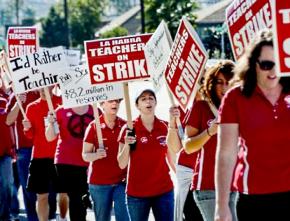Pay cut sparks teachers strike
and report from a teachers' fight in Southern California.
TEACHERS IN an Orange County, Calif., school district were back on the job December 16 after a week on the picket line in a strike-turned-lockout.
The teachers, members of the La Habra Education Association (LHEA), walked off the job December 8 to force the district to the negotiating table in an effort to stop a permanent 2 percent pay cut imposed by the school board in November.
Teachers voted to go back to work December 14 because the district agreed to negotiations. Nothing had been settled, but for the first time in California history, teachers were locked out of their classrooms for two days after the return-to-work vote.
LHEA pushed back by seeking--and winning--an injunction. A judge has ordered the La Habra school district to pay teachers for the two days that they were locked out.
"Everyone is still solid and strong," said Jim Rogers, a teacher at Imperial Middle School, who is also on the board of the California Teachers Association (CTA). "Although there's a lot of disappointment that this contract hasn't been settled, we're changing the focus and pace. We're encouraged by the injunction."

The strike came after a year of negotiations. The school board ignored a fact finder's report and took the unprecedented step of imposing a permanent 2 percent salary reduction--which also reduces state retirement payouts--two mandatory furlough days and cuts in health benefits.
The teachers say they would be willing to accept a 2 percent cut if it were temporary rather than a permanent reduction. But the school board's aggressive move to impose the cuts left teachers seething. They pointed to the district's $8.2 million reserve as they voted November 19 to authorize a strike. "The district imposed an unfair contract that was extreme and unnecessary--and then they refused to negotiate," said Rogers. "We had to strike."
The La Habra School District is small, with only five elementary and two middle schools. Consequently, the 225 teachers are a tight-knight group. They picketed outside each school and held rallies to build solidarity. Some 93 percent of teachers actively supported the strike.
Most dramatic is the level of parent support for teachers. At a meeting of the La Habra school board December 9, nearly 100 parents stood in line outside to pack the meeting--the boardroom only holds 140 people, showing how concerned with parent participation and democracy the school board really is.
Teachers got out of line to let parents go ahead. Then, to pack more parents in, all the children were sent outside to the teachers, who organized impromptu child care outside the meeting. Every single parent spoke either in support of teachers or about the levels of chaos at the schools in their absence. The school district reported student attendance on the third day of strike at just 62 percent of the normal rate.
The parent support is notable because 87 percent of children in the district qualify for subsidized lunches, and La Habra teachers are among the best-paid in Orange County. Still, parents seem to recognize that the relatively higher pay of their teachers explains a lot about the good quality of their schools.
According to Bill Guy, a union staff member, approximately 35 businesses in downtown La Habra have posted signs that read, "We Support La Habra Teachers! Settle the Contract!"
For now, the reduced pay for teachers remain in force, but the school board has been forced to return to the bargaining table.
THE LA Habra strike and lockout highlights the latest wave of attack on teachers' living standards, which has become a local expression of the austerity programs that leave working people from California to Ireland paying for the financial shenanigans of the elites.
In April, the Capistrano Unified Education Association struck for five days over a 10.1 percent pay cut, similarly imposed by the school board. San Juan Capistrano is on the opposite side of Orange County from La Habra. That strike failed to rescind the cuts, but won "restorative" language in the contract promising to undo the reductions as the economy improves.
And a few days after the Capistrano Unified School District imposed its draconian cuts on teachers, the Oakland Unified School District ignored a fact finder's recommendations and imposed a contract on its teachers that eliminated contractual class size caps (effectively, a speedup that results in a loss of teachers' jobs). Oakland teachers responded with a one-day strike.
The CTA was missing in action in those earlier fights. This time, however, the CTA has greatly ramped up its support. Calls for solidarity went out to CTA locals across the state, and they have begun pouring money into the La Habra strike fund. A Facebook group for La Habra teachers gathered hundreds of statements of solidarity, from as far away as Alaska and New York City. CTA President David Sanchez posted a reminder that "an injury to one, is an injury to all," urging strikers to stay strong.
But Sanchez didn't join the picket lines and remained in Washington, D.C., during the strike. He also missed the Oakland strike (when he was also in Washington) and walked the lines for only a single day in Capistrano (before going back to Washington again). The CTA's business unionism prioritizes lobbying over struggle, to great detriment in these dangerous times for public education.
The struggle in La Habra isn't over. But the strike shows how teachers can gain union solidarity and community support when they draw the line and fight back.


